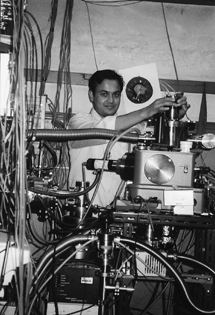Personal tools
News from ICTP 91 - Profile

Hem Raj Sharma, from Nepal, not only hopes to excel as a physicist but to raise the importance of physics in the country of his birth. His association with ICTP has enabled him to get off to a promising start on both fronts.
Nepal's High-Flying Physicist

Like many other young Nepalese students, Hem Raj Sharma's first ambitions in high school leaned towards medicine or engineering, which are regarded as secure career options with good earning potential.
Despite excellent grades in his high school graduation exams in 1989, Sharma didn't quite make it into either of these extremely competitive areas and he opted to study physics at Nepal's leading Tribhuvan University, the only university in the country to offer a master of science degree. Physics, Sharma thought, would allow him to switch to engineering at some point in the future.
An alteration in career plans was not the only major change he had to make when he arrived at the university in the bustling capital city of Kathmandu. Sharma comes from a remote rural district without electricity or running water and was taught in Nepalese at his state high school, not English as in the university. Within a few weeks, Sharma had to get used to a relatively new subject, a very different way of life and an unfamiliar language.
He withstood the challenge. In fact, changing culture, country and language seem to have become mainstays of his still early career as he moves from rural to urban Nepal, Japan, Italy, Germanyfollowing one opening after the other.
Once he arrived at Tribhuvan University, it became obvious that he and physics were going to get along just fine. In his first year, he was the top student in his class and the next year the top student in the entire college--a position he maintained, winning the gold medal for physics when he graduated with a master in science degree majoring in solid state physics. His record made him the obvious choice to represent his university on a one-year student exchange with Rikkyo University in Japan where he studied photoemission. The exchange took place in 1997.
In Japan, Sharma was impressed by his colleagues' autonomy and depth of knowledge--they were left to study on their own more than he was used to in Nepal and also had access to a wider range of equipment and published material. The latter, however, proved difficult for Sharma who did not read Japanese and often had to wait weeks for English-language versions of manuals to arrive. Typically, he started to learn the new language and, by the end of his stay, he could get by, despite a few problems with hard-to-translate technical terms.
Once back in Nepal, he would have been qualified to select engineering, but chose to stay with physics. His next move was to ICTP as a Diploma Course student in condensed matter physics. That proved one of the most decisive moves of his career. Not only did it allow him to see that he was on the right track both scientifically and professionally, but it brought him in contact with scientists from all over the world and helped him to formulate and realise new plans and ambitions.
Sharma managed to combine his studies with participation in an INFM-TASC (Italian National Institute for the Physics of Matter-Laboratory of Advanced Technologies, Surfaces and Catalysis) research project on photoemission. This, he believes, helped him win a place in a Ph.D. programme at Freie Universität Berlin in Germany in 1999, where he will be spending the next three years pursuing research on helium atom scattering and surface physics.
Sharma would then like to return to Nepal to help establish physics as a valid and valuable field of research in his native country. At the moment, there are few career options for physicists other than teaching and, as the son of a social sciences teacher, he can see that the underpaid and overworked life of a teacher is not enough to encourage young Nepalese to continue their study of physics beyond their first degree.
Sharma would like to change that by creating research opportunities in Nepal. He does, however, realise that such a change will likely take place only gradually in a country where government spending priorities must focus on such critical areas as food security.
Sharma, who has been in contact with several like-minded Nepalese colleagues, hopes to get something going within the next few years, possibly starting with research related to computational science before branching into other areas. In the meantime, he plans to continue his research abroad, preparing himself to bring home as much physics learning as possible when the right moment arrives.